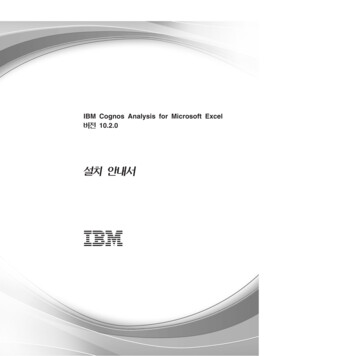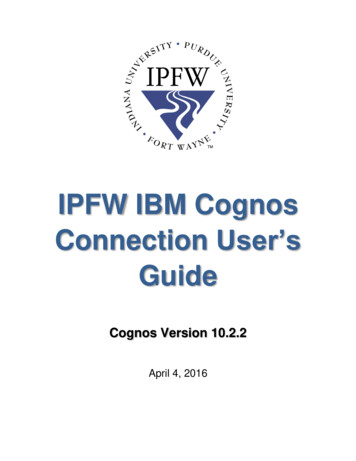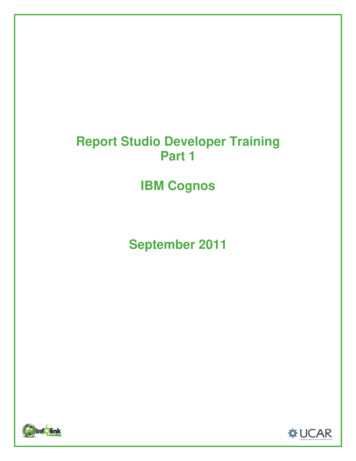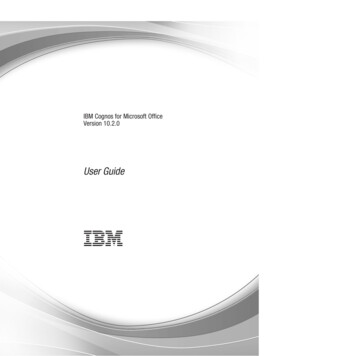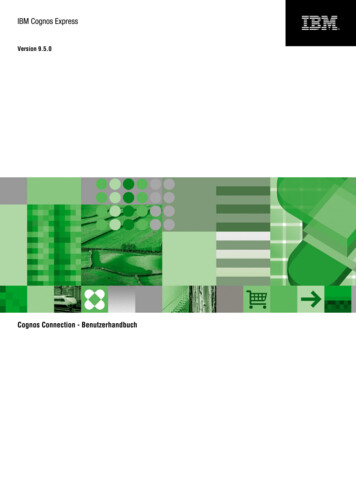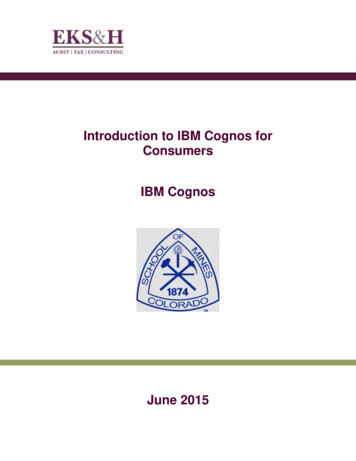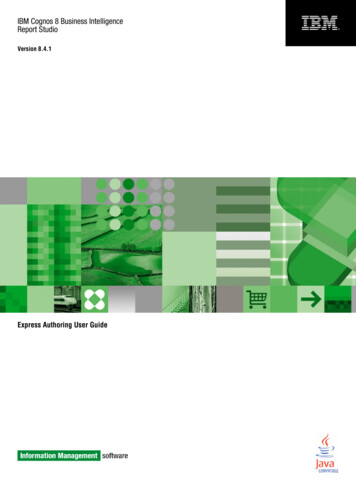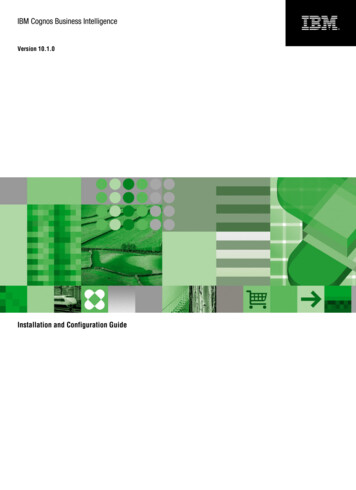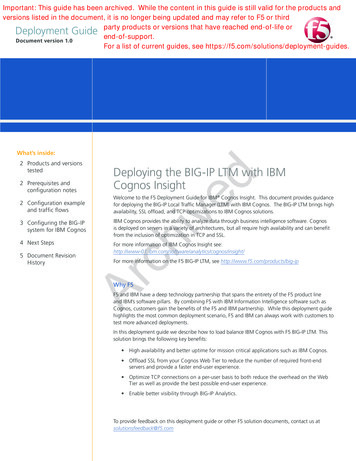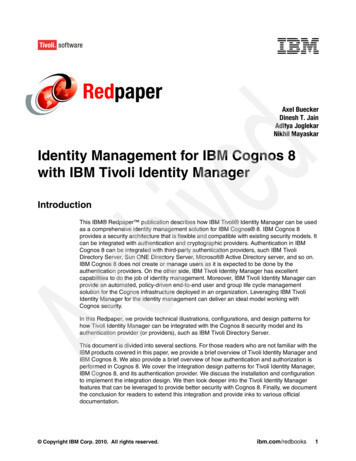
Transcription
RedpaperAxel BueckerDinesh T. JainAditya JoglekarNikhil MayaskarIdentity Management for IBM Cognos 8with IBM Tivoli Identity ManagerIntroductionThis IBM Redpaper publication describes how IBM Tivoli Identity Manager can be usedas a comprehensive identity management solution for IBM Cognos 8. IBM Cognos 8provides a security architecture that is flexible and compatible with existing security models. Itcan be integrated with authentication and cryptographic providers. Authentication in IBMCognos 8 can be integrated with third-party authentication providers, such IBM TivoliDirectory Server, Sun ONE Directory Server, Microsoft Active Directory server, and so on.IBM Cognos 8 does not create or manage users as it is expected to be done by theauthentication providers. On the other side, IBM Tivoli Identity Manager has excellentcapabilities to do the job of identity management. Moreover, IBM Tivoli Identity Manager canprovide an automated, policy-driven end-to-end user and group life cycle managementsolution for the Cognos infrastructure deployed in an organization. Leveraging IBM TivoliIdentity Manager for the identity management can deliver an ideal model working withCognos security.In this Redpaper, we provide technical illustrations, configurations, and design patterns forhow Tivoli Identity Manager can be integrated with the Cognos 8 security model and itsauthentication provider (or providers), such as IBM Tivoli Directory Server.This document is divided into several sections. For those readers who are not familiar with theIBM products covered in this paper, we provide a brief overview of Tivoli Identity Manager andIBM Cognos 8. We also provide a brief overview of how authentication and authorization isperformed in Cognos 8. We cover the integration design patterns for Tivoli Identity Manager,IBM Cognos 8, and its authentication provider. We discuss the installation and configurationto implement the integration design. We then look deeper into the Tivoli Identity Managerfeatures that can be leveraged to provide better security with Cognos 8. Finally, we documentthe conclusion for readers to extend this integration and provide inks to various officialdocumentation. Copyright IBM Corp. 2010. All rights reserved.ibm.com/redbooks1
IBM Tivoli Identity Manager overviewIBM Tivoli Identity Manager provides a secure, automated and policy-based user life cyclemanagement solution that can help effectively manage user accounts, access permissions,and passwords from creation to termination across the IT environment.Tivoli Identity Manager can help you reduce the administrative costs and improve productivitythrough automation, user self-service, and other innovative capabilities for managing useraccounts and access rights on various system resources. Figure 1 depicts the Tivoli IdentityManager system design.Figure 1 Tivoli Identity Manager (TIM) system designWe next look at several key components of the Tivoli Identity Manager architecture.Tivoli Identity Manager serverTivoli Identity Manager server provides core business logic and the provisioning platform foridentity life cycle management. The Tivoli Identity Manager server contains information forvarious policies that determine how login IDs are created, how passwords are created, whichusers get access to various resources, which requests require use of approvals found in theworkflow engine, and so on. The server is supported by the Lightweight Directory AccessProtocol (LDAP) directory and database storage unitsLDAP directoryThe Tivoli Identity Manager system uses an LDAPv3 directory server as its primary repositoryfor storing the current state of the enterprise it is managing. This state information includesthe identities, accounts, roles, organization chart, policies, and workflow designs.2Identity Management for IBM Cognos 8 with IBM Tivoli Identity Manager
DatabaseA relational database is used to store all transactional, reporting, and schedule information.Typically, this information is temporary for the currently executing transactions, but there isalso historical information that is stored indefinitely to provide an audit trail of all transactionsthat the system has executed.Web-based user interfaceTivoli Identity Manager introduces a new dual-user interface that shows users only what theyneed to do their job. The interfaces are separate and users access them through separateWeb addresses. Tivoli Identity Manager has two types of user interfaces, a self-care interfaceand an administrative console interface: Self-care user interfaceThis interface provides a simpler subset of personal tasks that apply only to the user. Administrative console user interfaceThis interface provides an advanced set of administrative tasks, and has new multitaskingcapabilities.Managed resources and adaptersAny IT resource, such as operating system, database, file, directory, or mail server that TivoliIdentity Manager supports for user provisioning, is called a managed resource. Adaptersserve as the links between the Tivoli Identity Manager server and the managed resources inan organization's computing system. An adapter is an interface that functions as a trustedvirtual administrator, managing the user accounts on its assigned platform. Note that aseparate adapter exists for each distinct type of managed resource supported by TivoliIdentity Manager. For a resource that is not supported by Tivoli Identity Manager, you maydevelop a custom adapter by using IBM Tivoli Directory Integrator technology.See the IBM Redbooks publication Identity Management Design Guide with IBM TivoliIdentity Manager, SG24-6996 and the IBM Tivoli Identity Manager 5.1 productdocumentation1 to get more details about its architecture, components, and typicaldeployments.IBM Cognos 8 overviewIBM Cognos 8 provides performance management and facilitates quick decision-making forbusiness performance. It delivers the complete range of business intelligence (BI) capabilitiesincluding reporting, analysis, dashboards, and scorecards on a single, service-orientedarchitecture (SOA): ReportingReporting gives you access to a complete list of self-serve report types that are adaptableto any data source, and can operate from a single metadata layer for a variety of benefitssuch as multilingual reporting, ad hoc querying, and scheduling and bursting. You canauthor, share, and use reports that draw on data from all enterprise sources for betterbusiness decisions.1The Tivoli Identity Manager Version 5.1 information center is located lp/v2r1/index.jsp?topic /com.ibm.itim.doc/welcome.htmIdentity Management for IBM Cognos 8 with IBM Tivoli Identity Manager3
AnalysisAnalysis enables the guided exploration of information that pertains to all dimensions ofyour business, regardless of where the data is stored. Analyze and report against onlineanalytical processing (OLAP) and dimensionally aware relational sources. DashboardsBusiness dashboards communicate complex information quickly. They translateinformation from your various corporate systems and data into visually rich presentationsusing gauges, maps, charts, and other graphical elements to show multiple resultstogether. ScorecardsScorecards help you align your teams and tactics with strategy, communicate goalsconsistently, and monitor performance against targets.Figure 2 shows the IBM Cognos 8 product portfolio.Figure 2 IBM Cognos portfolioIn addition to the BI capabilities, IBM Cognos 8 delivers a wide suite of financial performancemanagement products. Several of these are: IBM Cognos 8 PlanningThis finance-managed solution provides real time visibility to the resource requirementsand future business needs. IBM Cognos TM1This product provides a real-time approach to consolidating, viewing and editingenormous volumes of multidimensional data.4Identity Management for IBM Cognos 8 with IBM Tivoli Identity Manager
IBM Cognos 8 ControllerThis product provides finance organizations with unmatched capabilities for managing theclosing, consolidation, and reporting process.Figure 3 shows the IBM Cognos 8 Performance Management system.Figure 3 Cognos 8 Performance Management systemIn short, IBM Cognos 8 can enable an organization to better understand and improve itsbusiness based on the following questions: How is the overall organization doing financially? Why is the situation the way it is? What can the organization do to improve?See the IBM Cognos 8 product documentation2 to learn more about the architecture and suiteof products.Cognos 8 authentication, authorization and accessIBM Cognos 8 does not authenticate users itself but rather relies on third-party authenticationproviders such as LDAP or Microsoft Active Directory to do so. This concept means that IBMCognos 8 presents logon data (essentially credentials) entered by the user or obtainedthrough single sign-on (SSO) mechanisms to the third-party authentication providers onbehalf of the user. Then, when authenticated, IBM Cognos 8 must read the user's groups androles from the authentication provider as well and make them available to the authorizationfunctionality. This task is implemented by authentication providers.2The IBM Cognos 8 v4 Business Intelligence information center is located 8r4m0/index.jspIdentity Management for IBM Cognos 8 with IBM Tivoli Identity Manager5
After the users, groups, and roles are visible in the Cognos Connection, authorization policiescan be created wherein a user can be assigned to a group or role depending on the businessrequirements.The flow of an authentication request in Cognos 8Let us look at a typical flow of an authentication request in Cognos 8, shown in Figure 4.Figure 4 Flow of an authentication request in Cognos 8When a user requests authenticated access to IBM Cognos 8, the flow is as follows:1. The user clicks a report or analysis to view it, and the request goes through the gatewayand the dispatcher to the presentation service.2. The gateway accepts the request and sends it to a dispatcher.6Identity Management for IBM Cognos 8 with IBM Tivoli Identity Manager
3. The dispatcher notes that no passport is attached to the request, and sends the request toContent Manager.4. Content Manager sends the request to Access Manager.5. Anonymous access is disabled in this IBM Cognos 8 system, so Access Manager sendsthe request back to Content Manager with a fault attached. The fault contains informationabout what is needed to log on. For example, if multiple namespaces exist, the user will berequired to select a namespace. If only one namespace exists, the user might be requiredto provide a user ID and password.6. Content Manager returns the request with the attached fault to the dispatcher.7. The dispatcher sends the request to the presentation service.8. The presentation service creates the appropriate logon page for the user, and returns thepage through the dispatcher and the gateway to the user.9. The user enters the required information, such as a user ID and password. Theinformation is attached to the original request and sent through the gateway to thedispatcher.10.The dispatcher sends the request to Content Manager.11.Content Manager sends the request to Access Manager.12.Access Manager talks to the authentication provider through the Authentication Serviceto verify the supplied credentials. If all the required information is correct, Access Managerissues a Passport ID, attaches it in the HTTP header to the original request, and sendsthe request back to Content Manager. If the required information is incorrect orincomplete, the request faults back to step 9.13.Content Manager sends the request to a dispatcher.14.The dispatcher processes the request and sends it to the presentation service.15.The presentation service sends the Welcome page back through the dispatcher and thegateway to the user.Authorization and the CAMIDWhen a user is authenticated, the passport that is issued is the object that holds the visas. Foreach namespace, a visa is issued by the authentication provider after successfulauthentication has been established. In this case, the passport will hold a one-to-manynumbers of visas. The Passport ID is the reference to the passport object, which ismaintained, in memory, by the Content Manager component. The Passport ID is inserted inthe cam passport cookie, which is used to confirm that the user has successfully beenauthenticated in his or her current session before. Here, a user’s identity is established,confirming access to the Cognos Portal content.IBM Cognos 8 indicates which groups and roles the user is a member of, directly or indirectly,through inheritance (nested group memberships). This is true for groups and roles from thenamespace for which the particular Passport ID has been issued, plus groups and roles fromthe Cognos namespace.Authorization in IBM Cognos 8 applies to basically all objects that make up an IBM Cognos 8application. All content (reports, analysis, folders, packages, and so on) and a wide range offunctions and capabilities of systems can have permissions attached to them (for example,access to Studios). Permission defines who, a user, group or role, has what privileges on anobject/capability/function.Identity Management for IBM Cognos 8 with IBM Tivoli Identity Manager7
The five privilege levels within IBM Cognos are: READWRITEEXECUTETRAVERSESET POLICYInternally, those privilege levels do not contain the names of users, groups, or roles, butinstead contain an internal ID named CAMID3. The CAMID is constructed by theauthentication provider for each object read in from an external authentication provider. Thisalso applies to the internal authentication provider, so all the objects of the Cognosnamespace have a CAMID assigned to them. By the user of this CAMID, IBM Cognos storesand verifies access to objects, when authorization is necessary. The CAMID of objects in theuser’s identity is compared to the permissions assigned to an object, and if they match, theprivileges are granted or denied. Although the CAMID is built differently among authenticationproviders, they all use a common layout. The CAMID layout is a string, consisting of two fieldsthat are concatenated:CAMID: "CAMID( NamespaceID : AuthProviderSpecificID )"The NamespaceID is the ID that is specified in Cognos configuration for the namespace. TheAuthProviderSpecificID is an ID that is constructed internally by the authentication provider.Two examples are as follows: Example 1, User:CAMID("LDAP:u:uid admin,cn admin,ou support")Where:– LDAP is the NamespaceID– uid admin, is the user Relative Distinguished Name (RDN )– cn admin, ou support, is the Distinguished Name (DN) Example 2, Group:CAMID("LDAP:g:cn admin,ou support")Where:– LDAP is the NamespaceID– cn admin, ou support, is the Distinguished Name (DN)Note: This ID is not officially documented because it is considered internal and subject tochange without further notice. The layout documented here is current as of Cognos 8.4,however it might change in future versions without notice. Currently theAuthProviderSpecificID is composed from a type field, indicating the type of entry andsome ID string. Type is one of: u for user, g for group, and f for folder. ID totally depends onthe provider.Leveraging Tivoli Identity Manager with Cognos 8Cognos 8 supports various authentication providers, such as Microsoft Active DirectoryServer, LDAP, SAP, NT LAN Manager (NTLM), Cognos Series 7, and so on. Theseauthentication providers store users, roles, and groups that can be used inside the Cognosenvironment while enabling the authentication mechanism. On the other side, the TivoliIdentity Manager supports most of such authentication providers as managed resources that38Cognos Access Manager IDIdentity Management for IBM Cognos 8 with IBM Tivoli Identity Manager
it can manage. Tivoli Identity Manager provides capabilities of provisioning users and groupson most of the managed resources that Cognos uses as authentication providers. TheMicrosoft Active Directory server, IBM Tivoli Directory Server, or Sun ONE Directory Serverare examples of such authentication providers.Leveraging Tivoli Identity Manager for managing users and groups on the authenticationprovider can deliver an ideal combination with the Cognos 8 security model. Further sectionsprovide details about how Tivoli Identity Manager can be integrated with an authenticationprovider and leveraged with Cognos deployments.Several key advantages for Cognos 8 when Tivoli Identity Manager is used with the Cognosauthentication provider (or providers) are: Tivoli Identity Manager provides a centralized, policy-driven and automated end to endprovisioning solution. Administrators can use the Tivoli Identity Manager Web-interface tomanage users and groups on multiple authentication providers and performingadministrative tasks on it rather than directly operating on the authentication providers'individual user interfaces. Tivoli Identity Manager allows provisioning policies that can be defined and customized asper the need. A provisioning policy can help to ensure an appropriate user gettingprovisioned with appropriate access rights. Approval workflows and e-mail notifications can be configured with all user provisioningactivities, such as creating a user account on the authentication provider, user requestingan access to certain groups, and so on. Tivoli Identity Manager provides a self-care user interface that allows users to performbasic operations on their own without an administrator's involvement, such as resettingpassword, requesting access to groups, viewing and updating of personal information, andso on. Tivoli Identity Manager provides the ability to certify and validate a user's access to ITresources on a regular interval. An administrator can define a recertification policy thatrecertifies user accounts as well as access rights defined on the authentication provider. Auditing and reporting users and their access rights is one of the critical needs of mostorganizations. Tivoli Identity Manager's User and Access Reports can be leveraged toextend the existing Cognos auditing capabilities by providing auditing and reporting(traceability) of identity information of the authentication provider that accesses Cognoscontents. Provisioning users on the authentication provider, based on the organizational roles thatare defined in Tivoli Identity Manager (advanced scenario), can provide a role-basedaccess control mechanism and the following benefits:– Role hierarchy helps to simplify and reduce the cost of user administration by enablingthe use of an organizational role structure.– Separation of duties can strengthen security and compliance by creating, modifying, ordeleting policies that exclude users from membership to multiple roles that may presenta business conflict.Integration architectureIn this section, we describe how Tivoli Identity Manager can be integrated with the Cognos 8security model. An integration architecture diagram is shown in Figure 5 on page 10.Identity Management for IBM Cognos 8 with IBM Tivoli Identity Manager9
Figure 5 Integration architectureAs Figure 5 shows, Cognos 8 is enabled for one or more authentication providers. Anauthentication provider defines and maintains users, groups, and roles, and it also controlsthe authentication process. Each authentication provider known to IBM Cognos 8 is referredto as a namespace. User name, ID, password, regional settings, and personal preferencesare several examples of information that is stored with the providers.If authentication is set up for IBM Cognos 8, users must provide valid credentials, such asuser ID and password, at login time. IBM Cognos 8 does not replicate the users, groups, androles that are defined in the authentication provider. However, that information can bereferenced in IBM Cognos 8 while setting up the access permissions to reports and othercontent. Users can also become members of Cognos groups and roles.Tivoli Identity Manager manages users and groups on such authentication providers and candeliver an automated and policy-based user management solution throughout their life cycle.Tivoli Identity Manager provides centralized user access to disparate resources in anorganization, using policies and features that streamline operations associated with userresource access. In the following sections we provide more details about two sampleapproaches for utilizing Tivoli Identity Manager for managing the users from authenticationproviders.Simple design approachIn this first design approach, we provide a simplified sample design of how Tivoli IdentityManager, an external authentication provider, and Cognos 8 security can be integratedtogether.10Identity Management for IBM Cognos 8 with IBM Tivoli Identity Manager
The approach discussed here does not use any of the default Cognos users or defaultCognos groups. However, several of the existing built-in Cognos roles are used, rather thanhaving to create new ones.An important note is that this approach can be considered a simple approach because it doesnot involve defining roles in Tivoli Identity Manager.The procedure is as follows:1. Enable Cognos 8 security with an authentication provider configured for users andgroups.2. With Cognos 8, create Cognos groups, Cognos roles, or both, within the Cognosnamespace to secure the content objects. Existing default Cognos roles can also be usedrather than creating new ones.3. Define an HR feed in Tivoli Identity Manager for creating Person entries along with theirTivoli Identity Manager accounts.4. Configure Tivoli Identity Manager to manage the users and groups on the Cognosauthentication provider by creating a service that supports the authentication provider as amanaged resource.5. Define or configure a provisioning policy in Tivoli Identity Manager that deals with theaccount creation on the managed resource (authentication provider for Cognos).6. Optionally define an adoption policy in Tivoli Identity Manager that can associate useraccounts from the authentication provider to their respective Person entries in TivoliIdentity Manager.7. Define appropriate operations and policies on Tivoli Identity Manager as part of users andgroups provisioning.8. Perform user (accounts) and group management operations on the authenticationprovider from Tivoli Identity Manager.9. In Cognos security, define access permissions and capabilities with Cognos groups andCognos roles.10.After objects are secured against the groups, roles, or both, in the Cognos namespace,add the authentication provider’s groups and users to the appropriate Cognos groups andCognos roles.These steps are illustrated in n “Configuring the integration” on page 13, where we providemore practical insights about this approach.Advanced design approachIn this second design approach, we provide an advanced sample on how Tivoli IdentityManager, an external authentication provider and Cognos 8 security can be integratedtogether. We use this approach to provide an overview of how role based provisioning can beperformed with Tivoli Identity Manager.Compared to “Simple design approach” on page 10, this approach defines roles in TivoliIdentity Manager and performs user account provisioning based on these roles. The usersrequest access to Tivoli Identity Manager roles rather requesting access to the groups.This approach does not use any of the default Cognos users or default Cognos groups.However, several of the existing default Cognos roles are used rather than creating new ones.Identity Management for IBM Cognos 8 with IBM Tivoli Identity Manager11
An important note is that roles defined in Cognos are different than roles defined in TivoliIdentity Manager. The procedure is as follows:1. Enable Cognos 8 security with an authentication provider configured for users andgroups.2. With Cognos 8, create Cognos groups, Cognos roles, or both within the Cognosnamespace to secure the content objects. Existing default Cognos roles can also be usedrather than creating new ones.3. Configure Tivoli Identity Manager to manage the users and groups on the Cognosauthentication provider by creating a service that supports the authentication provider as amanaged resource.4. Using Tivoli Identity Manager, create groups on the authentication provider or run thereconciliation operation to import existing groups into the Tivoli Identity Managerrepository.5. Define static roles in Tivoli Identity Manager. For each group that exists in theauthentication provider, ensure that at least one role is defined. As an example, for theAuthors group that is created in the external authentication provider, create a static roleAuthors in Tivoli Identity Manager. Also ensure that Common Access is enabled for each ofthe role.6. Define or configure provisioning policies in Tivoli Identity Manager that deal with accountcreation on the managed resource (authentication provider for Cognos). Ensure that foreach role, a provisioning policy is created and that it also defines group membershipparameters as part of its entitlements.Perform the following steps with each of the provisioning policies to be created:a. Ensure that the policy has the Membership Type parameter selected as Roles specifiedbelow.b. Select the appropriate role name that you created earlier. For example, in the case ofthe provisioning policy for the Authors role, ensure that Authors role is selected as thepolicy member.c. With the Entitlements configuration, ensure that you have selected the group name asa parameter with the constant value selected as the group name from theauthentication provider.7. Define an HR feed in Tivoli Identity Manager for creating Person entries and their TivoliIdentity Manager accounts. Ensure that each user has at least a role associated with it.8. Optionally, define an adoption policy in Tivoli Identity Manager that can associate useraccounts from the authentication provider to their respective Person entries in TivoliIdentity Manager.9. Define the appropriate operations and policies in Tivoli Identity Manager as part of userand group provisioning.10.Perform user (accounts) and group management operations on the authenticationprovider from Tivoli Identity Manager.11.In Cognos security, define access permissions and capabilities with Cognos groups andCognos roles.12.After objects are secured against the groups, roles, or groups and roles, in the Cognosnamespace, add the authentication provider's groups and users to the appropriateCognos groups and Cognos roles.Note that the advanced approach provided in this section is not discussed further in thispaper. This approach is described here only to provide some direction toward how you canuse role-based provisioning with IBM Tivoli Identity Manager.12Identity Management for IBM Cognos 8 with IBM Tivoli Identity Manager
Configuring the integrationIn this section, we illustrate the design implementation of the approach listed in “Simpledesign approach” on page 10.We show how Tivoli Identity Manager can be configured with an authentication provider thatCognos 8 uses for the authentication purposes. We illustrate various Tivoli Identity Managerfeatures that can be used to manage users and groups for Cognos 8.Our authentication provider is the IBM Tivoli Directory Server, and we refer to it as the LDAPserver in this scenario. Users and groups are created on the LDAP server by using TivoliIdentity Manager. These users will access the Cognos 8 content. Several of the defaultCognos roles are used in this integration scenario rather than creating new ones.PrerequisitesBefore configuring this integration scenario, an important task is to evaluate whether theauthentication provider is supported by Cognos 8 as well as Tivoli Identity Manager. Beforeyou configure the integration, see the respective product's support documentation.Ensure that the following prerequisite software is installed and running properly: IBM Tivoli Identity Manager 5.1 is installed with the LDAP adapter service. IBM Cognos 8.4 is installed with sample content, that is, imported sample reports andpackages in the public folder for the purpose of demonstrating the authorization andaccess process. IBM Tivoli Directory Server 6.2 is installed and configured with the suffix O IBM,C US. ThisLDAP server is used as an authentication provider with Cognos 8 security.Configuration with Cognos securityThe provider we demonstrate here is a full authentication provider that implements all thefunctionality required by Cognos 8 to communicate with an authentication provider, including: User authentication using external authentication providers Namespace searchesThe searches can retrieve namespace objects and their properties, as required by IBMCognos 8. The objects can be users, groups, and roles, which are then used forauthorization purposes in the IBM Cognos namespace. Trusted Credentials Management Authentication provider configurationPerform the following steps to configure Tivoli Directory Server as an authentication providerwith Cognos 8:1. Navigate to the IBM Cognos Configuration Security Authentication folder.2. In the folder, right-click and select Namespace resource to add a new namespaceresource to the Authentication folder.3. Give the namespace a name such as TDS-LDAP and select a type of LDAP from the Typemenu. Click OK.4. Enter the required parameters, such as server info, and so on.Identity Management for IBM Cognos 8 with IBM Tivoli Identity Manager13
5. Finally, test whether the namespace is properly configured by right-clicking on the newlycreated namespace and selecting Test.The fully configured TDS-LDAP namespace is shown in Figure 6.Figure 6 LDAP namespace configuration14Identity Management for IBM Cognos 8 with IBM Tivoli Identity Manager
6
with IBM Tivoli Identity Manager Introduction This IBM Redpaper publication describes how IBM Tivoli Identity Manager can be used as a comprehensive identity management solution for IBM Cognos 8. IBM Cognos 8 provides a security architecture that is flexible and compatible with existing security models. It


